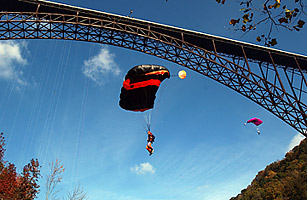
In 1783, Louis-Sbastian Lenormand climbed to the top of an observatory tower in Montpellier, France, leaned over the edge, and jumped. An astonished crowd watched as he fell to the ground with the aid of a new contraption called the parachute and landed unhurt.
The legend of the daredevil building-hop continued Oct. 18 with the 29th annual Bridge Day in Fayetteville, West Virginia — the largest group BASE jumping event in the world. 383 people made the 876-foot leap off the New River Gorge Bridge. Only three were taken to the hospital, making it a successful year: three people have died during Bridge Day, the most recent being in 2006.
A BASE jump is a parachuted jump from a fixed object — a mountain, a building, anything that rises high into the air. The term is an acronym for the types of structures off of which jumpers fling themselves: Buildings, Antennas, Spans and Earth . Carl Boenish, a cinematographer who had been filming freefall parachuting for several years, coined the term in 1981 as a way to categorize various jumps.
Although the sport’s name is only 27 years old, the idea has been around ever since Lenormand took his first step off the building to test his parachute — a contraption resembling an oversized umbrella, which he had invented to help people escape burning buildings. On February 2, 1912, in much the same spirit, 35-year-old Frederick Law jumped off the Statue of Liberty’s observation platform. He and his 100-pound parachute landed with a thud on Liberty Island’s stone coping, a few yards from the water. A Russian man named Vladimir Ossovski performed a similar stunt a year later when he jumped from a bridge in Rouen, France into the river Seine. In 1975, a member of the CN Tower’s construction crew parachuted off the building — at 1,815 feet , the world’s tallest free-standing structure — and was promptly fired. That same year, a man from Queens parachuted off the top of the World Trade Center and was arrested by security guards once he landed.
BASE jumping is significantly more dangerous than skydiving — five to eight times as likely to result in injury or death, according to a Stavanger University study. The lower altitude and shorter fall provides almost no room for parachute error, and jumpers’ proximity to the base object leaves open the possibility of hitting something on the way down. Pull your ripcord too early, and your parachute might get tangled or turned around. Open it too late, and you can guess what happens next. Death is a real possibility and because of this, many countries have outlawed the sport. BASE jumping is illegal in almost every American city and national park. However, there are still a couple legal jumping spots in the U.S.: Perrine Bridge in Twin Falls, Idaho, and the New River Gorge’s Bridge Day. To qualify for Bridge Day, a jumper will have to have already skydived or BASE jumped at least 100 times, have jumped within the past 2 years, and have completed a training course. But experience doesn’t necessarily mean safety: in 2006, BASE Jumping pioneer Brian Lee Schubert, a 40-year veteran of the sport, fell to his death during Bridge Day when his parachute opened too late.
Norway has become a popular vacation destination for thrill seekers because it still permits BASE jumpers on many of its fjords. But it, too, is a dangerous place: in 1984, Boenish died from a failed jump off Trollveggen, the tallest vertical rock face in Europe. He had just set the record for tallest BASE jump a few days before — Trollveggen is 3,600 feet tall — when his parachute failed to open. After 11 accidents and another three deaths, BASE jumping was banned at the site.
As long as there are mountains and skyscrapers, there will be people who want to jump off of them. The adrenaline rush, that first step off the ledge and into emptiness, the feel of the air as it whips across your face — these are the thrills that jumpers seek, and they are willing to risk their lives to find them.